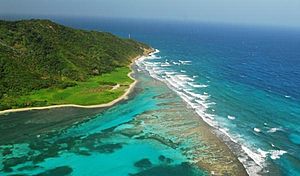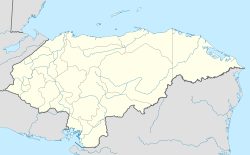Guanaja facts for kids

NASA satellite photograph of Guanaja
|
|
| Geography | |
|---|---|
| Location | Caribbean Sea |
| Coordinates | 16°28′N 85°53′W / 16.467°N 85.883°W |
| Archipelago | Bay Islands |
| Area | 50 km2 (19 sq mi) |
| Administration | |
| Department | Islas de la Bahía |
| Demographics | |
| Population | 5538 |
| Official name: Sistema de Humedales de la Isla de Guanaja | |
| Designated: | 25 October 2021 |
| Reference #: | 2456 |
Guanaja is one of the beautiful Bay Islands of Honduras, located in the Caribbean Sea. It's about 70 kilometres (43 mi) off the northern coast of Honduras. The island is also just 12 kilometres (7.5 mi) from its neighbor, Roatan.
Most of Guanaja's 5,538 residents live on a small island nearby. This tiny island is also called Guanaja, or sometimes Bonacca or Low Cay, but people often just call it The Cay. This busy little cay has canals running through it, making some people call it the "Venice of Honduras." Other main towns on Guanaja include Mangrove Bight and Savannah Bight. Smaller places are Pelican Reef, East End, and North East Bight.
The people of Guanaja mostly earn their living from fishing and shrimping. Tourism is growing, with small resorts for divers, snorkelers, and adventure travelers. The island's clear, warm waters are home to a huge coral reef. This reef is part of the Mesoamerican Barrier Reef System, which is the second largest barrier reef in the world after Australia's Great Barrier Reef. Guanaja still has fresh water and even some waterfalls. Since 2021, the entire island and its small cays have been recognized as a protected Ramsar site, which means it's an important wetland area.
Contents
History of Guanaja Island
Early Discoveries and Names
Christopher Columbus arrived at Guanaja during his fourth voyage in 1502. This was a special moment because it was the first time he encountered cacao, the main ingredient in chocolate! He landed on Soldado Beach, on the north side of the island. Later, settlers from the Cayman Islands moved to the Bay Islands. This is why both Spanish and English are spoken there.
Guanaja has had many names over the years. When Columbus arrived, he called it Isla de Los Pinos (Isle of Pines). However, its original inhabitants already knew it as Guanaca. This name appeared on maps as early as 1511. English pirates and settlers later changed the pronunciation to Bonacca. Even though the Honduran government officially named it Guanaja, older residents still often call it Bonacca.
Settlers and Communities
The main settlement, The Cay, got its name from "Lower Cays." The Haylocks were among the first families to settle there. They moved to the small cays near the main island to escape bothersome flies. Other families like the Boddens, Phillips, and Woods joined them, and by the 1880s, a lively community had grown.
The village of Savana Bight was started by families from Olancho. Later, the Watlers from the Cayman Islands also moved there. Other families from Grand Cayman, like the Tatums, Merrens, Bennetts, and Forbes, settled in an area they called East End. The Parchmonts settled in some of the upper Cays. The first families in North East Bight were the Ebanks, Hydes, and Greenwoods.
Angelo Elwin was the first person to settle on the upper north side of the island. His wife was a Moore, and her brothers followed her from Barbarat to Bonacca. The Moores and Elwins had come to the Bay Islands from Belize. The Moores bought land from Elwin and built their homes in what is now called Mangrove Bight. They were later joined by the Powerys, Johnsons, and Jacksons.
Hurricane Mitch and a Recent Fire
In October 1998, Hurricane Mitch caused a lot of damage. Most of the buildings and homes on Guanaja were destroyed. The islanders have since rebuilt their communities. Even though the economy was affected, tourism has been recovering. The mangrove and pine forests, which were also destroyed by the hurricane, are slowly growing back.
More recently, on October 2, 2021, a large fire swept through the island. It destroyed about 200 buildings. The Honduran military helped put out the flames by dropping water from the air. Luckily, no one was hurt.
Island Traditions
Guanaja has its own special culture and traditions, especially during holidays. For example, on September 15 (Honduras Independence Day), October 31 (Halloween), and December 25 (Christmas), people celebrate with something called "Old Junk" or "Junkanoo." This involves groups of people wearing masks and old clothes, even palm trees, running through the streets of The Cay. It's a fun part of their culture that has been done for many years.
Nature and Wildlife
Important Bird Area
Guanaja is part of the Islas de la Bahía y Cayos Cochinos Important Bird Area (IBA). This means it's a very important place for birds. It's home to many white-crowned pigeons, chimney swifts, and yellow-naped amazons.
Climate of Guanaja
Guanaja has a tropical monsoon climate. This means the weather is very warm to hot and humid all year round. The amount of rain changes, from moderate to very heavy. This depends on the strength of the northeast trade winds and any Caribbean hurricanes.
| Climate data for Guanaja | |||||||||||||
|---|---|---|---|---|---|---|---|---|---|---|---|---|---|
| Month | Jan | Feb | Mar | Apr | May | Jun | Jul | Aug | Sep | Oct | Nov | Dec | Year |
| Mean daily maximum °C (°F) | 28 (82) |
28 (83) |
30 (86) |
31 (87) |
31 (88) |
32 (89) |
31 (88) |
31 (88) |
32 (89) |
30 (86) |
29 (85) |
29 (84) |
30 (86) |
| Mean daily minimum °C (°F) | 25 (77) |
25 (77) |
26 (78) |
27 (80) |
27 (81) |
28 (82) |
27 (81) |
28 (82) |
28 (82) |
27 (80) |
26 (78) |
25 (77) |
27 (80) |
| Average rainfall mm (inches) | 220 (8.6) |
120 (4.7) |
81 (3.2) |
58 (2.3) |
69 (2.7) |
150 (5.8) |
260 (10.4) |
180 (6.9) |
150 (6.1) |
450 (17.8) |
420 (16.4) |
360 (14) |
2,520 (99.1) |
| Source: Weatherbase | |||||||||||||
People of Guanaja
Who are the Caracol People?
The Caracol people are a group of English-speaking people who have lived in Northern Honduras, especially the Bay Islands, since the early 1800s. They are mostly of African descent with some European background. Many of them originally came from other English-speaking Caribbean islands. They came to work on building railroads and banana farms for the United Fruit Co.. "Caracol" is a Spanish word that means "conch," "snail," or "shell." This name connects the people of the Bay Islands to their unique ocean environment and their history of seafaring.
English is the first language for all native islanders, no matter their background. Spanish is usually spoken as a second language. This is different from mainland Honduras, where Spanish is the main language. This is because the Bay Islands used to be a British colony. More people from mainland Honduras are moving to the islands, so Spanish is becoming more common. However, because of tourism and cruise ships, English is still the main language spoken by native islanders. The English spoken by the Caracol people has changed over time. It's a bit different in how words are formed, pronounced, and sometimes in grammar and vocabulary. But it's similar enough that people from all the Bay Islands can understand each other.
Getting Around Guanaja
 |
|
| The lighthouse is at the end of the land | |
| Coordinates | 16°29′53.3″N 85°49′01.8″W / 16.498139°N 85.817167°W |
|---|---|
| Foundation | concrete base |
| Construction | steel post |
| Tower shape | cylindrical post with light |
| Markings / pattern | white and red horizontal band post |
| Height | 12 metres (39 ft) |
| Focal height | 22 metres (72 ft) |
| Range | 19 nautical miles (35 km; 22 mi) |
| Characteristic | Fl W 9s. |
Transportation on Guanaja is mostly by boat. In 2006, there were only three cars on the island! By 2011, there were about 40. There is only one road, which goes from Mangrove Bight to Savannah Bight. A special waterway called "The Canal" lets boats travel from the south to the north side of the island without going all the way around.
Guanaja has its own airport, Guanaja Airport (GJA). As of 2011, you could fly to Guanaja from La Ceiba on the Honduran mainland. There was also a ferry twice a week from Trujillo. Now, there are also daily flights from Roatan to Guanaja. You can also travel between Roatan and Guanaja by the Galaxy ferry on certain days.
Images for kids
-
NASA satellite photograph of Guanaja
See also
 In Spanish: Guanaja para niños
In Spanish: Guanaja para niños







